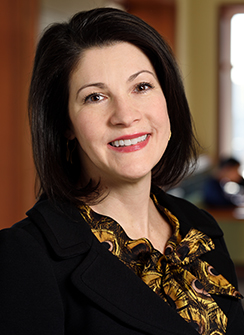Tick, tick, tick. Cheryl Dennison Himmelfarb, PhD, RN, ANP, FAAN, professor and associate dean of research, was counting the seconds until a fresh, more proactive Hypertension Guideline was to be published. Himmelfarb, co-author of the Guideline, knew it would be a life saver. But until it was in print—advocating intervention much sooner and a “high blood pressure” label for lower readings, among other key measures—many people were at higher risk of stroke, cardiovascular disease, and death.
With that wait over, Himmelfarb took a few moments to share the thinking behind the changes. “The term ‘prehypertension’ was a well-intentioned way to nudge patients toward healthier choices,” explains Himmelfarb, who also directs the Helene Fuld Leadership Program for the Advancement of Patient Safety & Quality. “Instead, it could give a false sense of security, and a reason to stall. ‘I’m not in danger yet.’ By the time you actually started calling it hypertension, avoidable damage might have occurred. So ‘prehypertension’ needs to go.”
The new definition of hypertension (anything at or above 130/80) will translate to an increase to almost 50 percent—from 1 in 3—of the adult population in the United States with hypertension. However the vast majority of those newly diagnosed would not be prescribed medication but rather guided to modify their lifestyles immediately to lower blood pressure.
In addition to more aggressive treatment, the Hypertension Guideline emphasizes an individualized approach that involves shared decision-making and support. That’s where nurses come in, Himmelfarb says: “We need to empower patients to know their numbers—their blood pressure levels vs. the goals, their athersclerotic cardiovascular disease (ASCVD) risk—and offer strategies for self-managing high blood pressure.”
On this, the clock is still ticking. Here are some things Nurses Need to Know (read the full list of recommendations and more from Cheryl Dennison Himmelfarb in the Spring 2018 issue of Johns Hopkins Nursing):
- Risk for heart attack, stroke, and other consequences of high blood pressure begins at any systolic level above 120. (The risk doubles, for instance, at a systolic blood pressure of 130 compared to 120.)
- Blood pressure in the range of systolic 120-129 and diastolic below 80 is now classified as elevated. Hypertension is now defined as blood pressure above 130/80 and as Stage 1 (systolic 130-139 or diastolic 80-89) or Stage 2 (systolic above 140 or diastolic above 90).
- Nonpharmacologic therapy (weight loss, a low-sodium, high-potassium diet, limited alcohol consumption, and physical activity most days of the week) is now recommended for ALL with elevated blood pressure and Stage 1 and Stage 2 hypertension.
- Stage 1 is the threshold for recommending blood pressure-lowering medication in addition to nonpharmacologic therapy for those with comorbid conditions such as diabetes, chronic kidney disease, heart failure, stable ischemic heart disease, and peripheral arterial disease. First-line blood pressure-lowering medication agents include thiazide diuretics, calcium channel blockers, and angiotensin converting enzyme (ACE) inhibitors or angiotensin receptor blockers.
- The new Guideline recommends a health system-level intervention that incorporates a multidisciplinary team that may include a primary care provider, cardiologists, nurses, pharmacists, physician assistants, dietitians, social workers, and community health workers. A multifaceted approach should include support for clinical decision making, collaboration, adherence to prescribed regimen, blood pressure monitoring, and patient self-management.

